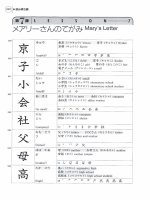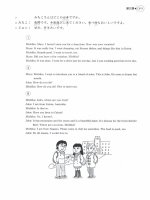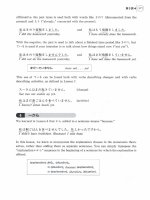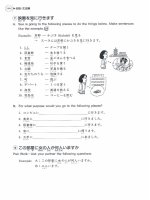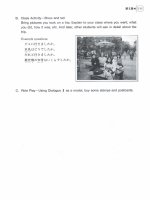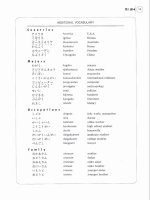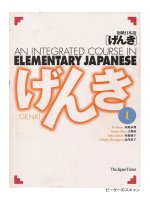genki 1 an integrated course in elementary japanese1 phần 7 docx
Bạn đang xem bản rút gọn của tài liệu. Xem và tải ngay bản đầy đủ của tài liệu tại đây (4.31 MB, 34 trang )
affirmative,
the
past
tense
is
used
both
with
words
like
3
3
(disconnected from
the
present)
and
t
i
("already,"
connected
with
the
present).
?At33a,3%5%2
Ld-
tk,
bt:
L
La<f:it
I
did
the
hamework
yesterday.
and
$L,ld%?j~&~&~?zo
hf:L
Ln(t:r>
I
have
already
done
the
homework.
With the
negative,
the
past
is
used
to
talk
about
a
finished
time
period
like
3
-5
,
but
T
L1&
is
used
if
your
intention
is
to
talk
about
how
things
stand
now
("not
yet7').
3.At$3@.i%SSB2
t3-@LTtko
bt:~
~s<f:r,
1
did
not
do
fhe
hmework
yesterday.
and
$Lid3
f?@B%
LT~~~-+kh0
+&I-
~~(f<rh
I
have
not
done
the
homework
yet,
3E-7313i2h
have
mt
.
.
.
yet
This
use
of
-iI
&\
5
can
be
found
both
with
verbs
describing
cha~ges
and
with
verbs
describing
activities,
as
defined
in
Lesson
7.
~-3hE33
$533
ccr~\3*&0
ki
Sue
has
not
woken
UP
yet.
(change)
$2.12
3
t<&
L*13
A,
i?
T
L
3
*Ao
(activity)
hf:L
v
&
tz
I
havea't
eatgn
lunch
yet
We
learned
in
Lesson
6
that
;Ira&
added
to
a
sentence
means
"because."
q~ia~~r*ta~~e-;.~*~-it.tf=,
~t
L~~~TzTT~~~,
ML
Bjs
\
*t
I
didn't
have
brhkfast.
(Became)
I
was
busy.
In
this
lesson,
we
learn
to
incorporate
the
explanation
clauses
in
the
statements them-
selves,
rather
than
adding
them
as separate
sentences.
You
can
simply
transpose
the
"explanation+
6%
b
"
sequence
to
the
beginning
of
a
sentence
for
which
the explanation
is
offered.
=
(situation),
because
(explanation).
=
(explanation),
fherefore,
(situation).
&Lf=SR&pib6-hab,
~Alf+R%Bt3Td
L
it&
AM
:
LLIAXL
3ri
I
will
study
this eve~ing,
beccame
we
will
have
an
encam
tomorrow.
(=
We will
have
aft
exam
tmorrow, therefore,
I
will
study
this
evming-)
9S&h7khaL;,
*haCf2+thTLfto
?t-
T
We
didn't
go
out,
because
it
was
cold.
(=It
was
cold,
therefore,
1
didg't
go
ouA)
Note
that
the
resulting
order
of
elements
resembles
that
of
a
"therefore"
sentence
more
closely
than
that
of
a
"because"
cIause
in
English.
Before
the
conjunction
hS
6,
you
find
both
the
long
and
short
forms.
Thus
the
75%
1;
clauses
in
the
above
examples
can
be
rewritten
as
ih
L
SRhP&
9
3
Thx
i3
and
Sh.9
ft
TTh-
L
IiX.
2
t-
h
.'
The
long
form
before
2~
b
is
more
polite,
and
is
frequently
found
in
request
and
suggestion
sentences.
&G:3a!a%d2;fj9
&T&lL;,
>$1:RC-$T3a
Lk
3.
3-
.i:
i\?L
x
k
1\
Let's
go
to
see
Kabuki
1
have
tickets.
'The
long
form
before
zk
i3
is
inappropriate
when
the
entire
sentence
ends
in
a
short
fom,
however.
Thus
it
is
inappropriate
to
say:
X
S
ha
7
f"
TTh3
I;,
&hhlf
23'
7
kc
$2
T
,$!#El
Practice
h
Lw5
1:
Short
Forms
Past
A.
Verbs
(a)
Change
the
following
verbs
into
the
past
affirmatives.
Example:
75'
(
4
haL
\?=
(b)
Change
the
following
verbs
into
the
past
negatives.
Example:
5'.
(
-hihi%$'7
?
1.
&&
2-
T-c&
3-
Tt2
4.
Itrhd?
b
(to
throvi
away)
3.
1i
(
6.
tdU2b
7.9{&
8.
*X/k
(T6
9.
i$lbq
lo.
(
a
11.
~15
12.
$
A,Y~
~5
13.
Si326
14.
9fz-j
15.
hxk?,$
16.
q'if-;t;'
B.
Adjectives
and
Nouns
@
(a)
Change
the
following
into
the
past
affirmatives.
Example:
7"z
-ha
L
1
+
~~PS~r3~7~~
G?X,3
2
+
f,L3f?3fz
$<(*L\
-+
&'*(*L\f;*<f<
(b)
Change
the
following
into
the
past
negatives.
@
Informal
Speech
A.
Using
the
cues
below,
make
questions
about
yesterday
in
informal
speech.
How
do
you
answer
those
questions?
@
Example:
?-
t
W
&
3,
b
k
+
Q:
4@.jTLY2R?:?
k.
A
:
3
h,
E7t=,/.j
9
A,
RQ$xq
fz,
k
k
1.
t0Y2&*8
f:
2.
&*T&
SA,
(3'
3.
BS@T$i?%
9
&
z
L
1
/"
fZ/v
h-
4.
?G??%ET&
+-i
r
5.
i&TH=T6
9x3
'I
6.
&??Gi:&?
Y
C
A
7.
S32%2&
f;X.Z'
B11
8.
$%&I*
b
hf?li
<
9.
S%i:%%2rSx13
$
d.
F<
T/L
h
10,
~2F~-Y-~f~~
-2
*.
11.
.f.&%%bj
7
$'A
12.
2giy*bzfi
<
h
+
I
r
13.
%%T$
i
/Lri
14.
F'47:ztTgb
.GY
Make
questions
about
childhood
in
informal
speech.
How
do
you
answer
those
questions?
@
Example:
Z%
Irk
I
+
Q
:
TEae.
ZRE7
i?z
?
:rt
r
~f/ct
A
:
5
XI,
Z%t57
t=,/-j
5
A,
XaU
e
Qhx9
f:,
Ifd
5
IT&
3
@Z%f2.ot=tE~ltd
lfh
d
%%
A.
Make
a
guess
about
the childhoods
of
the people
below.
@
Example:
2
%,
T*
t
?z
hso
ITX.
3
+
Q
:
L
o3ACATiEa%,
%%T
tf~6'~
ur
;rt
r3
lfk3
A
:
IdLh,
ZRI?'~~
t=
Z4%Ll&
To
if/"
3
st
L\L\&,
Z~~:'Q&~~~?ZZ,U
IT/"
3
=
~\3
3-0
i4
b
(a)
7
F>f
lZ3LjT
(about
~adonna)
(b)
E~*Z@%*~Z~L\T
(about
your
Japanese
teacher)
I
I
z
WhWL!
6.
Choose one classmate and
guess
what
they
were
like
as
a
child
using
the
following characteristics.
A.
Pair
Work-Ask
your
partner
the following questions about his/her childhood
and
report
to
the
class
using
&EgTL\ZLfi.
11
Example:
L
\
:'
ib
Q
L
?:
B.
What
would
these people
say/have
said?
Make
up
your
own
quote
for
the
following
people.
Example:
7'-
30
j
f:
(
s&g@Lf=z$-;,~~~\
+LC?
I5
Ex.
3a71t';lz%~Z'*-
(1)
?/f91L-
7~9"/>
(2)
II~FZ-~~X')-
(4)
@
1
[my]
mother)
13
n
A.
Look
at
the
picture
below
and
answer
the
questions.
Example:
€El
3
f:
375.
+
Q
:
E3+3hiiZ*QlAT?ha,
fz
oif.
vr
A
:
b&rib2$*l-f.lil~\&hTT,
fi~\
b
L f-2%T~l\
ATT,
v
z
L
5
4
rP
Y
B.
Pair Work-One
of
you
looks
at
picture
A
below
and the
other looks
at
picture
B
(p.
188).
Ask
each
other questions
and
identify
all the
people
in
the
picture.
Example:
k
L
5
A
:
$;
L
2
3
hid
~''C?lh"i.'~fi',
Pr_-
B
:
~~~"~RTLGATT,
A
L'
z
Picture
A
Ask
which
of
the
people are
the
following:
1.
f-zs
-3
-
2.
3kjL
3.
~:-L\$C+
4.
L.ir
C.
Class
Activity-Descri
be
your classmates.
The
class is divided
into
two
groups,
A
and
6.
Each
member
of group
A
acts
out
something
and
freezes in
the
middle
of
doing
so.
Members
of
group
B
answer
the
teacher's questions,
using
TLl5APT.
Take
turns when finished.
U&
Example:
Teacher
:
T
4
7
3
A,
Ci
F~AT"p;tra,
D
r
Student
:
*$Z$ZLTi:L\bATT,
(32
jL:/<
It
r
A.
Answer the following questions using
bk ?IL\bl2h.
@
Example:
Q
:
&
j
&
X/
??
&<
2
L
?=
fia,
Y'S
f:
B.
Pair
Work-Ask
if
your partner
has
done
.
. .
yet.
Example:
352
6
2
&<
4
+A,
f:
1.
H#Mk:*%
L
n
2.
:igtcXb
t;h-%/,
iill
3.
-f-%%
(Lesson
10)
??
%
L'
LvbY
?.
d
4.
75';:
3
-2
R
kc8
(
A
li
5.
&W,b
h
(a
name
of
newly
released
movie)
6.
53
{
(a
name
of
newly
released
CD)
7.
,7&
+*
v76
a
(a
name
of
current
best-selling
novel)
A.
Match
up
the
phrases
to
make
sense.
B.
Complete the foltowing
sentences
adding
reasons.
1.
&>
b,
%&75WL*&&
"I
2
*Ao
A-kI
2.
hXL;.
Et*%%%i%
LT~:L\~
To
1:
(TX-
z'
</,,3~
3.
sfixb,
5~wm~13~rt
'tdx3
71t~~~
QA,CIP~
Lmi37
c>+e
4.
hSL;,
3~3?FR21*&4.3
Lko
Q~TZ
i
ri
mgefr3cnag
;(zhrbwJ5
A.
Role
Play-One
of
you
is
working
at
a
fast-food
restaurant.
The
other
is
a
customer.
Using
Dialogue
IU
as
a
model, order
some
food
and
drinks
from
the
menu
below.
Be
sure
to
say
how
many
you
want.
B.
Answer
the
following
questions.
2,
T9-2%
(
9hzk.fT-Phh,
U
ck=J
7
3.
%&c3h3*3Tj-r3>,
%f
-f
4.
E!%@e,
k
<
S2fkA2
3-h~~
5
3
r
l
7
0,
5.
{
~9
t
a
w,
?A
IT
6.
&q@S*El
(birthday)
I~fl&~&
&,L\$
tk-hh,
31
h&
f=h.Lii
d
Qt:
T:t-Ltzm$
Tt
bb3
tk6x0
r*
bt
7.
+B.
9
~xra+m=wt
3
4
t
?z$~,
~+t:,%b
9
3
$ha,
31
i
&'?LC
1iu
Q/"
r
i;
8.
TTY~~~
1.P
t
9.
f%a%.
k
<
&Ti&
z
sv+3
L
f<h>,
r
L
r
t
h
e
10.
z''AQEa
b
k-T-W+9
Tbd
T6ao
t'p,
t
11.
+~oi$~t~s
L
~1
r
,ge
-w,
.,
cX,r
Lllh.
CTh.
12.
&3?=9ETIJ.
Z%2X$-'Y~~J.%~~&
9
3-f*ho
{
1:
IIX,
3
Pair
Work
@
B.
Example:
k
L
2
I
picture
B
.
I
Ask
which
of
the
people
are
the
following:
There
are
two
kinds
of
words
for
colors.
Group
1:
LI-adjectives
I
X~J>
black
fi
bi
L
r,
white
I
<
&
h
Q-
red
SLX
&
84
blue
I
3w5kh
yellow
8
g
brown
3
597)
%+\\&
1
These
words
become
nouns
without
the
r>.
I
Group
2:
nouns
red
bag
I
like
red
the
best.
*%,'
7*
1)
-
2
I
green
%
a%33
I
F>7
pink
7&
I3
kTr.6
light
blue
1
(
%$/;/,b~.t
?kt\&
silver
I
There
words
need
a
in
order
to
make
noun
phrases.
>B/7*1]
-
>Ql-k-9-
green
sweater
='I
Here
are
some
words
related
to
colors.
You
look
pale
bhck
ad
white
picture
Mary
hQs
Blo&
hair.
&#&(n-f;z
"srs,
Winter
Vacation
Plans
ifww
*
&
Ft"r
@
At
a
travel
agency.
Mary:
It
is
getting
cold.
Takeshi:
Yes.
Mary,
what
will
you
do
at
winter
break?
Mary:
I
am
planning
to
go
to
Korea
or
Taiwan,
but
I
haven't decided yet.
Takeshi:
That's
nice.
Mary:
Which
do
you
think
is
better,
Korea
or
Taiwan?
Takeshi:
Mm
.
. .
I
think
it
is
warmer
in
Taiwan.
But
Sue
said
that
the
food
was
deTicious
in
Korea.
Mary:
I
see.
By
the
way,
are
you
going
somewhere,
Takeshi?
Takeshi:
I
won't
go
anywhere,
I
don't
have
money,
so
I
will
stay
here.
Mary:
Is
that
so?
Then
1'11
buy
some
souvenir
for
you.
Takeshi:
Wow,
thank
you.
May:
I'd
like
to
reserve
a
plane
ticket
from
Osaka
to
Seoul.
Travel
agent:
When
is
it?
Mary:
December
19.
Travel
agent:
We
have
a
morning
flight
and
an
afternoon
flight.
Mary:
A
morning
flight,
please.
Can
I
me
a
credit
card?
Travel
agent:
Yes.
Mary:
How
long
does
it
take
to
Seoul?
Travel
agent:
About
one
hour.
Nouns
23
3
L\LP
2.3
g&5ifa%%
3
429
*
?k=s~;~
b73-F
ZZt
?by&-
.;/
*
'7
4&b\hX-3
*$*L\
bhx-c=)
T"2
{
4
r
r+i3
ra
s
J$>',!I
VL
9
*
VXI
2,
&I
+,4@5
vpi
#~\t'k
*
k*(
i;
k\&P-=l
3
3
&2*
fall
doctor
station
~3ch
person
face
season
credit
card
this
year
soccer
shirt
life;
living
world
subway
gloves
barber's
spring
pants
beauty
parlor
flight
ship;
boat
baseball
celebrity
reservation
next
semester
apple
Warm
slow;
late
cool
(weather-not
used
for
thin&
cold
(thing/~eo~le)
sleepy
*
Words
that
appear
in
the
dialogue
easy;
simple
to
take
(amount
of
tirne/moneyl
(no
particle)
to
stay
(at
a
hotel,
etc.)
(-
1;)
to
become
to
pay
to
decide
Irregular
Verb
;izhL@iTB
&ET6
to
practice
Adverbs
and
Other
Expressions
&
&
'f%T
9~b-C
on
foot
t\%l%k
+I$
best
or
for
. .
.
months
in
.
.
.
time;
after
.
.
.
these
days
for
. .
.
weeks
by
(means
of
transportation);
with
(a
tool)
how;
by
what
means
which
which
how
much;
how
long
. .
.
years
(do
something)
early;
fast
In
Japanese,
adjectives
have
the
same
shape
in
noncumparative
and
comparative
sen-
tences;
there
is
no
alteration
as
in
"great/greater."
The
idea
of
comparison
is
expressed
by
adding
something
to
the
nouns
that
are
compared.
1
A
tDMjjbt
B
@'
property),
=
A
iS
more
@r~erM
than
B.
I
You
can
ask
for
another
person's
opinion
on
two
things
in
comparative
terms.
AtB
tk
~=?3~133~;hf
(pro~ert~),
=
Befween
A
and
B,
which
is
mre
(property)?
XCX
Z
e*
Z
Z''9
3;
9
C3
j
V~L
\TT&a,
~LLF
r
i
Which
zs
cheaper,
koing
by)
bm
or
(by)
$rain?
yr
In
comparison
among
three
or
more
items,
the
degree
qualifier
\
S;
1%
k
is
used.
[(class
of
items)
a271
A
tiiL18lbh
(property).
A
is
the
most
(property)
[amg
(a
class
of
items)].
I~F~u~~?.~
Z
75
L-72
Z
p
-
=
>3*n+T1
~:&~~)~L\~;E%X/&$~,L+~"SZ,SL~
2
73.
3:
Cri
3'
H&
3
-f+,
Betwee%
Pavarotti,
Curreras,
and
Domingo,
who
do
you
think
ZS
the
best
si~ger?
'In
red
life,
the
phrases
A
1%
i
h.'
and
B
I
1
often
appear
in
the
reverse
order,
making
it
very
easy
to
be
misled
into
believing
the
opposite
of
what
is
actually
said.
Don't
rely
on the
word
order,
therefore,
to
decide
which
item
is
claimed
to
be
superior.
Listen
carefully
for
the
words
nC3
3
4'
and
1
1
.
'There are
several
alternates
for
Z-9
t;
@
13
i
.
They
are:
ft;
b
C3
5
,
F7
&,
and
f%
41.
Any
one
of
these
can
be used
in
question
sentences
seeking
comparisons
between
two
items.
Y'7
3;
ad
Z+T
f3
e)
(3
5
are
slightly
more
colIoquia1
than
r'S;
b
and
If%
b
mi3
=I
.
h
I."J.'RY.?.F
hi~\3;t%X/&-h'.k+T~o
if:
Uri
?"
Pavarotti
is
best,
naturally.
Note
that
the
words
43
i
and
Y-;1%
are
not
used
in
statements
of
comparison
among
three
or
more
items.
Normal
question
words
like
fzh,
Z*&,
and
a(-
are
used
instead.'
When
a
noun
follaws
an
adjective,
and
when
it
is
clear
what
you
are
referring
to,
you
can
(I
replace
the
noun
with
the
pronoun
CT),
one."
You
can
use
a
to
avoid
repetition.
$.A.~&,~k~-k-9 ~$+9
fb3
-f0
*bW%%-3
04
To
(a=*-5'-)
hf;L
<
-5
C
ha.
-
b
I
haw
a
bkack
sweafer.
I
h~oe
a
9.d
me,
to.
SL~FS~RWICE~
a
LTZ,
-~-$~\~\a~i&lq
-
a-wxtt;,
(@=%$I
c*
ULl
?F
,,
"
c
Lk
I
wmf
to
buy
casa
inexpmsiue
dictionary,
bgt
there
were
no
goad
mes.
LI-adjective
1
Ll-adjective
1
+
+
noun
+
&-ad
jeclive
%-adjective
Similarly,
a
noun
following
another
noun
can
be
reduced.
Here,
a
sequence
of
the
form
"noun,
cF)
JIQU~~''
wi1I
be
reduced
to
"noun,
fl."
You
simply
omit
the
second
noun.
t
t-LtdX-
3
Aahh'tbA/TT&x,
~lt\ii,
*&Lt2%T1)
-3
ha
T9-0
1s
this
Sag3
&?
No,
that
is
Mary'sp.
7%IJfim74~7~]-Aat3j
&?H*4)
k
3
SL~LL~TT,
4ZCflU
-
Americm
ice
cream
is
more
dekicioas
fkaa
Jupawse
m.
3The
tendency
is
to
use
Yh
when
a
list
of
items
is
presented,
and
to
use
IbJ
r*
,-
when
a
group
is
referred
to
collectively.
Compare:
1
A,z*Zsih*Az
3
{
bLtTa+T.
=,+.
YhLJr\GCdA333C?h4,
-t
Whkh
do
you
like
best,
apples,
tangeriaes,
m
cham-es?
<
f<%
an+
T.
FJifJz~~.fjt%X/%5TThho
-r
mat
fmiF";Eo
yoG'iike
best?
9
$
9
follows
verbs
in
the
present
tense
short
forms
to
describe
what
a
person
is
planning
to
do
in
the
future-
You
can
also
use
a
verb
in
the
negative
plus
9
t
1
to
describe
what
you
me
planning
zot
to
do,
or
what
you
do
nof
intend
to
do.
verb
(present,
short)
+
3%
9
f:
@)
i~tend
to
do
.
. .
(3t.1d)S$.t-k13
L~XIZT-C-X??-$-&-~~%
'7
T-j-,
bGL
L.+ja7
1
z&md
to
play
fm~is
with
Tqkeshi
thik
weekend
&-F*&t3&
LkATt=*Q~~.3S
3
TTQ
92
Lf;++/t+r,
%L,&*{
:
=
Professor
Yamushifa
does
mt
intmxd
to
come
to
schol
tommow.
&+QW,t~fi(
3S
1
TLki-fY,
Xah"
l32~~7fz3~1;.
fi3
?~,
Ti)
k
I'
-IX:
2
L
T
We
were
plawna'~
to
vbit
a
tempk,
baf
we
diih't,
became
.the
weather was
no
f
good.
The
verb
3
5
means
"to
became,"
indicating
a
change.
3
8 f~llaws
nouns
and
both
types
of
adjectives.
- -
nouns:
9
3
SRHKZx5
fo
become
a
company
enaplqyee
%\L-PLG
fplItrpClh-
B*ZGF)&B&~%L
{
%!I
3
Lfzo
I:
[EX,
:
3
La,
St86dyzyzng
the
Japaaese
hguage
is
fan
%ow
(fbugh
it
was
like
fortare
hefore).
With
L\-adjectives,
the
final
r\
is
dropped
and
(
is
added,
as
in
their
negative
canjuga-
tions.
A
common
mistake
is
to
expand
the
pattern
of
3-adjectives
and
nouns
and
us
t:
with
\-adjectives.
It
is
wrong
to
say,
for
example,
X
@
$-
L
11:
Q
8.
W3.z
When
an
adjective
is
used
with
ta'
6,
a
question
axises
whether
the
sentence
describes
an
absolute
change
(ex.
"it
has
become
warm,
hence
it
is
not
cold
any
longern)
or
a
relative
change
(ex.
"it
has
become
warmer,
but
it
is
still
cbld").
3
6
sentences
are
ambiguous in
isolation.
If
you
want
to
make
clear
that
you
are
talking
in
relative
terms,
you
can
use
the
pattern
for
comparison
together
with
'b
&
.
Mary
has
become-beffer
ii-~apaike
tha~
before.
In
Lesson
8
we
learned
the
Japanese
expressions
for
"something"
and
"not
.
.
.
anything,"
4Ff2~-
and
2,.
As
you
must
have
noticed,
these
expressions
are
made
up
of
the
question
1:
r,
It
word
for
things,
.PT,
plus
particles
h*
and
S
.
Other
expressions
for
"some"
and
"any"
in
*i:
Japanese
follow
this
pattern.
Thus,
something
someme
fz+h$'
-
31:
-
not
azythi~g
a
%
Q
1:-
xot
aflymP:
7"Sh-
L
somewhere
YZ
fi*
-
mf
anywhere
tl"
L
S
As
we
noted
in
Lesson
8,
these
words
are
used
by
themselves,
where
particles
43,
$5
or
2
would
be
expected.
It
is,
then,
interesting
to
observe
how
these
expressions
interact
with
other
particles,
such
as
i:,
2,
and
C.
These
particles
appear
in
the
places
shown
with
underscores
above.
Let
us
look
at
some
examples.
Did
you
go
a~ywhere?
L\L\;?_,
rf'~-~t7,4
-
~~LTLTZ.
c
No,
I
didn't
go
anywhere.
~3&7Ft',&L
2
L
iF=
fiso
L\L\;~_,
t:fit~$&t~3~LTLfr,
-
d
R
Did
you
see
anybody?
No,
1
did~'f
see
aaybody.
rnd.
L
2
Lfz75%,
gid
you
do
artything?
LWL,
a$
t
a*tt-cLI-=,
2*
1:
No,
1
didn't
do
anything.
You
can
me
the
particle
Zt
with
nouns
that
describe
the
means
of
transporktian
and
the
instruments
you
we.
We
eaf
our
meals
with
chopsticks.
Let%
talk
in
Japanese.
I
went
to
the
station
by
bus.
I
saw
a
mvie
on
TV.
;f%&q%cfl@15f&g%Tfi'******b
We
sometimes
use
75'
and
tf
E
at the
t
ZhJ
2
z
uv
end
of
a
sentence when
we
want
our
partners
to treat what
we
have
just
said
as
a
given,
common
ground
to
buiId upon.
These
words
often
indicate
the
speaker's
intention
to
give
her
partner
a
chance
to
react and
speak
up.
By
relegating
the
right
to
speak
to
one's
partner,
they
also
contribute to the
politeness
of
one's
utterance.
In the dialogue, the
travel
agent
lays
out the
relevant
information
on
the
table;
there
are
two
flights, one
leaving
in
the
morning
and
another
in
the
afternoon.
6s
attached
to
her sentence
indicates
that
she
wants
to
build
upon,
and
move
forward
with, these
pieces
of
information. Instead of
asking
the
obvious
question,
namely,
r
'lij
6
aft
1
tlT?ds,
the
agent
chooses
not
to
finish
her
sentence,
and
lets
her
customer
come
forward
with
an
answer
immediately.
!RE!
Practice
nh
Lm5
A.
Look
at
the
pictures below
and
answer
the
following
questions.
@
Example:
Q
:
~$ZI~XZ
Z'.%~KI[~?
&ri&~~TThio
-,
,
.
.
7.
-:
,i+
A
:
@+o,t2
j
$cr;xa
9
:&L\TT,
,
.n
L-:
.Il,
,
Picture
(a)
(a)
1.
$&$$$$!Y)GZ
Z
Z'%
b
912
3
2~~S~lT-j-i~~~
L
L.+.x.+~.L
lar
2.
$fi$qR,#l
z
%*
z
Z+%
b
a12
9
&~s~\TT$~o
LXd./V+?A,
TALC
2
3.
#fie>#$
Z
YSZ
Z
Z*G
i,
Pli3
5
&'%$~hT?h~,
L/~$./~+L,
rf
4.
Z$
ZyCA
Z
Yh
i,
QIJ~
i
&2T$~\Ctha,,
TI"
L
3?
,;a
Picture
(b)
Picture
(c)
B.
Pair
Work-Make
questions
using
the
following
cues
and
ask
your
partner.
When
you
answer
the
questions,
add
reasons
for
your
answers,
if
possible.
Example:
E/*
(%
3)
7
.;.*
T
+
A
:
Ez*?
z*G~-,(Q~I~~)&~~~TT&~O
27
J.@
t
6
:
E~cJ~
-hx(+k
9
)e3T"Po
ta.
-i
i.VP
2
(orX%%S%3T$,/$SZ-&
3
~L~TT,)
k7
.;,W
T
27
.;.rb
A
:
r-5
l/?-i?T6L~
I.
47
!zl
H3z/
El
*$+39
(35
3
)
%*?~<'II?
1
:
I I
i
@~/%.5=i.#%
033)
;.
lP
:
i
?
i
E3*93/F4
'Y
(Germany)
(~kt'l)
I:
1ik
(62
<&?
i%F/?5
9
a?-
(7S~&f<'x.)
6.A
i'
33
7rt'7~+-7
;r-/;ty
n->
(~E$'L\L\)
&fS
?.55rt*
=i~5?"/-s*F>-f
(%&#+%)
o.n
I;
%/$A
(8
3)
I
A:-
T
a;$;a+/%Qf=ama+
(gjt,.~\)
I1I3,L
:
.
$f;S;
a*a*i%/&Qfzama&i&
(AEor%Lk\)
1
i
4+\xd.7
1:
7
f:i~ L
7:-
A.
Look
at
the pictures
on
the
previous page
and
answer the
questions
below.
Example:
Q
:
t
T,
Y.*#'Ldf
L\&
iyk$~\TT&~~
Qd.
;z
+
A
:
*%&&?k\%
lTtL*~\T-fO
L&iJ-/L4&L,
::
F
Picture
(a)
Picture
(b)
Picture
(c)
8.
Answer
the
following
questions.
Example:
ex%/%
3
-3
t:
Lo
-r
-+
Q
:
*<rna+T,
rn7SS~\%
la'&%
3
T-P&,
fz
to
275.
QiI
%
A
:
$LhP~\-f;Ea*X/%3T-$-,
i
C.
Group
Work-Make
a
group
of
three
or four
people.
Ask
each
other questions
and
make
as
many
superlative sentences
as
possible
about
the
group.
Example:
t
T,
A
3
I~~L%L\T+T,
2
*
bd%
B
3
X/h2Wi
13k%+hP&b\T-fo
f:d.
CS/L$i'~\Gl%kL
t:
({
97~Itt&&-j-~
t5
*
+
D.
Class Activity-First
form
pairs
and
make
comparative
and
superlative question
sentences
with your
partner.
(You
should
know
the answers.)
Then
ask
ques-
tions
to
the
class.
The
rest
of
the
class
answer
the
questions.
Example:
Y.
l.x
LX
b
Z
Z*%
b
e)C3
5
;s~&L\-c"-$-;~~,
-3.
r
?&
f;
h.
3
A
ZAB3
Z%
&@I39
$s35~hT?hho
f;
Bd. 93
f;
a%
h.
9'7za*T+af:~$~~~%i2A~*2#9
TL\~T&~~
'It-
'13
h.h
b
@%~~~+TFz-~~L~~;E~~.IJ~~L\T$$~.
Q
d.i,
<
L
Qh.
%il
